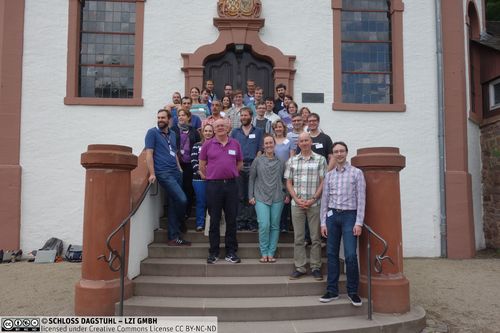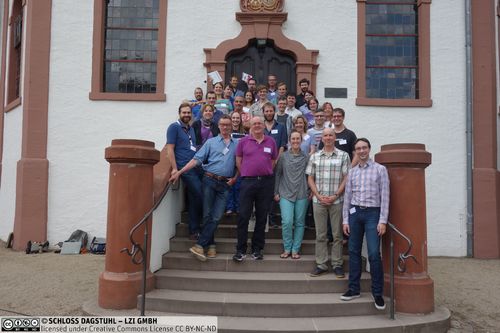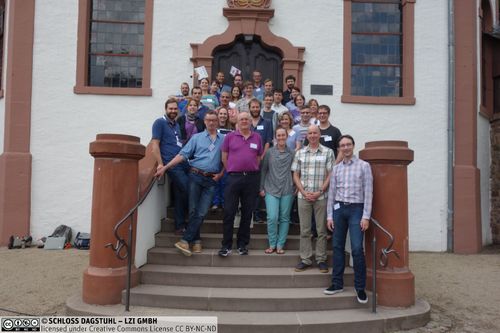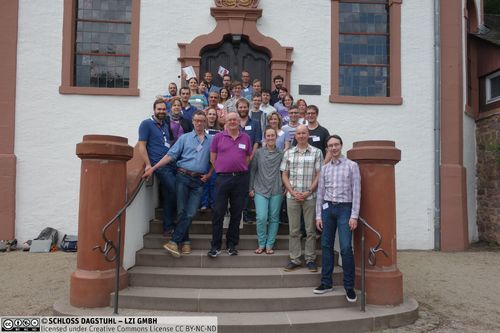Dagstuhl Seminar 17282
From Observations to Prediction of Movement
( Jul 09 – Jul 14, 2017 )
Permalink
Organizers
- Mark Birkin (University of Leeds, GB)
- Somayeh Dodge (University of Minnesota - Minneapolis, US)
- Brittany Terese Fasy (Montana State University - Bozeman, US)
- Richard Philip Mann (University of Leeds, GB)
Contact
- Susanne Bach-Bernhard (for administrative matters)
Schedule
Whether studying humans, animals, or machines, movement analysis is key to understanding the underlying mechanisms of dynamic processes. Analysis of movement trajectories is a core element of Movement Ecology in Biology, as well as being important across disciplines as diverse as Geographic Information Sciences (GIS), Transportation, Criminology, Epidemiology, Computer Gaming, and Phylogenetics. Development of efficient algorithms for analyzing and predicting will be vital to realizing the hopes for new generation smart transport systems and smart cities. Furthermore, naturally generated trajectories provide a fascinating context for mathematical and computational study of Geometry and Stochastic Processes. This seminar continues a series of previous seminars on the description, analysis, and visualization of movement trajectories, and brings the focus onto the modeling and prediction of movement in various domains.
In particular, we aim to address the following questions:
- What does it mean to predict a trajectory? Should we focus on predicting the spatial locations or the geometric properties?
- What are the potential uses of accurate trajectory prediction and what degree of accuracy is required?
- What is the relationship between accurate prediction and an understanding of the generating process? Can you have one without the other?
- To what extent movement observations convey information on the underlying behavior of moving phenomena?
- What is the relationship between movement and its environmental context? To what extent changes in movement patterns convey information on changes in the environment and vice versa?
- Can we build a classification of trajectory generating mechanisms and associated trajectory properties, such as navigation by waypoints, explorative foraging?
This seminar will bring together researchers from Animal Behaviour, GIS, Computational Geometry, Data Science and other fields to exchange insights from these diverse fields. Presentations will focus both on outstanding practical questions and study systems as well as on fundamental mathematical and computational tools. Participants will be invited to introduce their own study systems, current research problems and newly developed methodologies as the basis for discussion and work groups. We hope that these groups will form the basis of many exciting new collaborations and research projects in the years ahead.
 Mark Birkin, Somayeh Dodge, Brittany Terese Fasy, and Richard Philipp Mann
Mark Birkin, Somayeh Dodge, Brittany Terese Fasy, and Richard Philipp Mann
Dagstuhl Seminar 17282 took place at Schloss Dagstuhl from 9 to 14 July 2017. We had 29 participants and nine invited talks. The main theme of this seminar was the analysis and prediction of movement trajectories. In particular, we focused on the study of movement patterns of individuals, and the interactions of moving agents with each other and with the~environment.
Themes
Movement analysis is key to understanding the underlying mechanisms of dynamic processes. Movement occurs in space and time across multiple scales and through an embedding context that influence how entities move. The importance of spatiotemporal aspect of movement has attracted a wide range of studies. Analysis of movement trajectories is a core element of Movement Ecology in Biology, as well as being important across disciplines as diverse as Geographic Information Sciences (GIS), Transportation, Criminology, Epidemiology, Computer Gaming, and Phylogenetics. Development of efficient algorithms for analyzing and predicting will be vital to realizing the hopes for new generation smart transport systems and smart cities. Furthermore, naturally generated trajectories provide a fascinating context for mathematical and computational study of Geometry and Stochastic Processes.
A trajectory is a time-stamped sequence of locations, representing the movement of entities in space and time. Trajectories are often created by sampling GPS locations, but they can also originate from RFID tags, video, or radar analysis. Time-series of locations can also be associated with other {co-temporal data}, such as pressure recordings for avian or aquatic animals, activity sensors and accelerometers to measure energy expenditure, or the {myriad time-stamped data} recorded by modern smartphones alongside GPS locations.
The study of movement involves development of concepts and methods to transform movement observations (trajectory data) to knowledge of the behavior of moving phenomena under known conditions. This knowledge is then used to calibrate simulation models to predict movement and behavioral responses in varying environmental conditions. Figure 1 illustrates a continuum encapsulating fundamental areas of movement research for (1) {understanding movement processes} through trajectory representation and computational movement analysis (the right side of Figure 1); and (2) {modeling} behavior of moving phenomena and {prediction} of their responses to environmental changes though modeling and simulation approaches (the left side of Figure 1). These two processes are tightly connected and feed into each other, often through a validation procedure on the basis of real trajectory observations.
During recent years computational movement analysis tools for trajectory data have been developed within the areas of GIScience and algorithms. Analysis objectives include clustering, similarity analysis, trajectory segmentation into characteristic sub-trajectories, finding movement patterns like flocking, and relating patterns to context, and several others. Since these computations are mostly spatial, algorithmic solutions have been developed in the areas of computational geometry and GIScience. The basic analysis tasks for trajectory data are by now comparatively well understood and efficient algorithms have been developed to perform computational movement analysis. However, to be truly effective and to have real-world impact, trajectory analysis has to move beyond `understanding movement' and tackle substantially more involved questions in `modeling, simulation, and prediction' of movement responses to a changing environment or as results of (social) interactions.
Simultaneously, in the area of ecology the study of motion of animals has also become a topic of increasing interest. Many animal species move in groups, with or without a specific leader. The motivation for motion can be foraging, escape from predators, changing climate, or it can be unknown. The mode of movement can be determined by social interactions, energy efficiency, possibility of discovery of resources, and of course the natural environment. The more fascinating aspects of ecology include interaction between entities and collective motion. These are harder to grasp in a formal manner, needed for modelling and automated analysis. The basic analysis tasks for trajectory data are by now comparatively well understood and efficient algorithms have been developed to perform them. However, to be truly effective and have real-world impact, trajectory analysis has to move beyond these basic tasks and tackle substantially more involved questions, prime examples being (social) interaction and collective motion.
Research Approach and Questions Addressed
Trajectories are mathematical objects with geostatistical properties. Movement is a {process} that occurs as a response to the {state} of a {moving entity} across multiple {spatial} and {temporal} scales. The {state} and resulting {behavior} of moving entities determine the {characteristics} and {capacities} of movement (e.g., speeds, directions, accelerations, path sinuosity), which are highly influenced by interaction with environment, geographic {context}, and other moving entities. Internal properties of the moving agent such as its propensity to explore, or its power and size, typically distinguish the trajectory from that of other agents. As such no element of a trajectory can truly be independent of its other parts. Therefore, we take a view of trajectory analysis that emphasizes the treatment of the whole trajectory as a unit, rather than a series of moment-by-moment steps.
Trajectories are generated by some underlying process, which is typically assumed to integrate both stochastic elements (such as Brownian motion) and more deterministic interactions between the moving agent and the external world. Many research questions can be posed about such processes, but in this seminar we will focused primarily on identifying the forms of interaction, both with other moving agents and with environmental stimuli, and on predicting the characteristics of future trajectories.
In the seminar, we explored the following questions:
- To what extent movement observations convey information on the underlying behavior of moving phenomena?
- How susceptible are behaviors of moving agents to environmental changes?
- To what extent changes in the behavior of moving phenomena indicate changes in the environment?
- What does it mean to predict a trajectory? Should we focus on predicting the spatial locations or the geometric properties?
- How can we assess a predictive model?
- How can computational geometry help movement prediction?
- What characteristics of motion are indicative of specific trajectory generating processes, and how can we compute these efficiently?
- What is the role of time in trajectory analysis? Where can we analyze the shapes of paths independently of the time stamps and where are these vital to understanding the underlying mechanisms?
- Can we build a classification of trajectory generating mechanisms and associated trajectory properties, such as navigation by waypoints, explorative foraging
- What is the home range? Can we have a concrete definition for home range or activity space?
- What is a collective?
- Can we make algorithms that work across scales?
- To what extent goal oriented movement can be inferred from local movement patterns?
 Mark Birkin, Somayeh Dodge, Brittany Terese Fasy, and Richard Philip Mann
Mark Birkin, Somayeh Dodge, Brittany Terese Fasy, and Richard Philip Mann
- Sean Ahearn (City University of New York, US) [dblp]
- Mark Birkin (University of Leeds, GB) [dblp]
- Kevin Buchin (TU Eindhoven, NL) [dblp]
- Maike Buchin (Ruhr-Universität Bochum, DE) [dblp]
- Urska Demsar (University of St Andrews, GB) [dblp]
- Somayeh Dodge (University of Minnesota - Minneapolis, US) [dblp]
- Damien Farine (MPI für Ornithologie - Radolfzell, DE) [dblp]
- Brittany Terese Fasy (Montana State University - Bozeman, US) [dblp]
- Robert Holbrook (University of Leeds, GB)
- Maarten Löffler (Utrecht University, NL) [dblp]
- Jed Long (University of St Andrews, GB) [dblp]
- Robin Lovelace (University of Leeds, GB) [dblp]
- Richard Philip Mann (University of Leeds, GB) [dblp]
- Samuel A. Micka (Montana State University - Bozeman, US) [dblp]
- Harvey J. Miller (Ohio State University, US) [dblp]
- Jennifer Miller (University of Texas - Austin, US) [dblp]
- David Millman (Montana State University - Bozeman, US) [dblp]
- Nicholas Ouellette (Stanford University, US) [dblp]
- Kristine Pelatt (St. Catherine University - St. Paul, US)
- Andrea Perna (University of Roehampton - London, GB) [dblp]
- Kamran Safi (MPI für Ornithologie - Radolfzell, DE) [dblp]
- Jack Snoeyink (University of North Carolina at Chapel Hill, US) [dblp]
- Frank Staals (Aarhus University, DK) [dblp]
- Kathleen Stewart (University of Maryland - College Park, US) [dblp]
- Daniel Strömbom (Swansea University & Uppsala University) [dblp]
- Alexander Szorkovszky (Uppsala University, SE)
- Johan van de Koppel (Royal Netherlands Inst. for Sea Research - Yerseke, NL) [dblp]
- Carola Wenk (Tulane University, US) [dblp]
- Zena Wood (University of Greenwich, GB) [dblp]
Related Seminars
- Dagstuhl Seminar 08451: Representation, Analysis and Visualization of Moving Objects (2008-11-02 - 2008-11-07) (Details)
- Dagstuhl Seminar 10491: Representation, Analysis and Visualization of Moving Objects (2010-12-05 - 2010-12-10) (Details)
- Dagstuhl Seminar 12512: Representation, Analysis and Visualization of Moving Objects (2012-12-16 - 2012-12-21) (Details)
- Dagstuhl Seminar 14132: Interaction and Collective Movement Processing (2014-03-23 - 2014-03-28) (Details)
- Dagstuhl Seminar 16022: Geometric and Graph-based Approaches to Collective Motion (2016-01-10 - 2016-01-15) (Details)
Classification
- data structures / algorithms / complexity
- modelling / simulation
- networks
Keywords
- Trajectories
- movement
- geometric algorithms
- graph algorithms
- geographic information system
- agent-based simulation
- statistical models
- collective motion
- interaction
- smart cities
- mobility
- human health





 Creative Commons BY 3.0 DE
Creative Commons BY 3.0 DE
